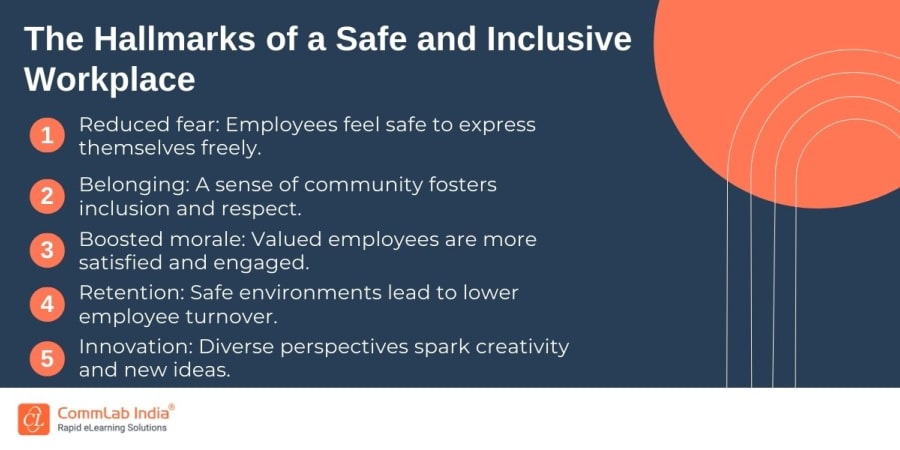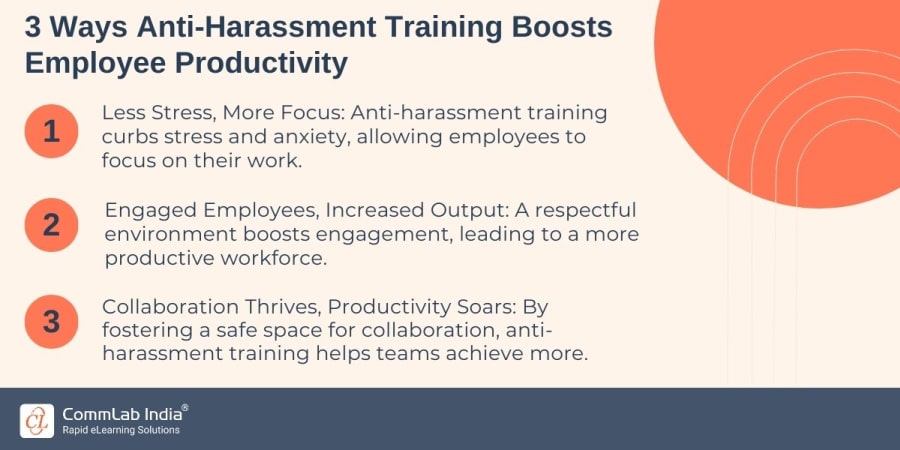Building a Culture of Respect: Why Anti-Harassment Training Matters?
Harassment hurting your organization? Anti-Harassment Training unlocks 7 benefits for a safe and thriving workplace. Read on to know how!

Have you ever wondered why Anti-Harassment Training is so important in today's workplaces? Think about Sarah, a brilliant software engineer brimming with innovative ideas. Initially excited about her new role, she soon finds herself the target of subtle, yet persistent, sexist jokes from a senior colleague. This behavior not only creates a hostile work environment for Sarah but also stifles her creativity and hinders her potential.
This scenario, unfortunately, plays out in workplaces more often than we'd like to admit. Experiences of harassment and discrimination, in all their various forms, create a climate of fear and silence, ultimately harming both employees and the organization as a whole. In today's competitive business landscape, fostering a safe and inclusive workplace is no longer just a moral imperative; it's a strategic advantage.
Why is Anti-Harassment Training Important?
Harassment and discrimination can create a hostile work environment, harming employees and the organization. Anti-Harassment Training goes beyond prevention. It equips employees to identify and report harassment, fostering a safe and inclusive workplace. This translates to benefits like increased employee morale, reduced legal risks, and a stronger employer brand.
Anti-Harassment Training: A Powerful Tool for Building a Culture of Respect
Anti-Harassment Training is more than a box to check; it's a powerful tool that empowers employees, builds a culture of respect, and unlocks the full potential of your diverse workforce. Effective anti-harassment training programs go beyond simply preventing harassment. They equip employees with the knowledge, skills, and confidence to identify, report, and address inappropriate behavior. This proactive approach fosters an environment where everyone feels valued, respected, and empowered to contribute their best.
While preventing harassment is crucial, the benefits of anti-harassment training extend far beyond.
7 Powerful Benefits of Anti-Harassment Training
1. Fostering a Safe and Inclusive Workplace
Effective anti-harassment training equips employees with the knowledge to recognize various forms of harassment and the tools to report them. This creates a safer and more welcoming environment for everyone. Employees feel valued and respected, leading to increased morale, satisfaction, and loyalty. A safe and inclusive workplace also fosters a sense of belonging, which can significantly improve employee retention. Imagine a company where Sarah thrives, her ideas are valued, and her full potential is unlocked. This is the power of a safe and inclusive work environment.

2. Reducing Legal Risks
Comprehensive anti-harassment training demonstrates your organization's strong commitment to providing a safe and respectful workplace. This proactive approach can help mitigate legal liabilities associated with harassment and discrimination claims. By demonstrating that you take these issues seriously and have taken steps to prevent them, you can potentially avoid costly lawsuits and settlements.
3. Promoting a Positive Company Culture
Anti-harassment training sends a clear message: your organization values respect, diversity, and inclusion. This positive culture is attractive to top talent. Studies show that diverse and inclusive workplaces are more innovative and productive. When employees feel comfortable bringing their authentic selves to work, collaboration thrives, and creativity flourishes. This positive company culture not only attracts and retains top talent but also strengthens your employers’ brand, giving you a competitive edge in the job market.
Is Your Workplace DEI-Ready? [Video]
4. Improving Employee Relations
Effective anti-harassment training fosters open communication and encourages employees to report harassment concerns without fear of retaliation. This builds trust between employees and management, leading to improved working relationships. When employees feel comfortable voicing concerns and confident that they will be heard and addressed, it strengthens the overall work environment. This fosters a sense of psychological safety, where employees feel comfortable taking risks and sharing ideas without fear of judgment or reprisal.
5. Boosting Employee Productivity
Employees who feel safe, respected, and valued are naturally more engaged and productive. Harassment, on the other hand, can create stress, anxiety, and decreased focus, all of which negatively impact productivity. Anti-harassment training helps mitigate these issues by creating a work environment where everyone feels comfortable contributing their best. Imagine a workplace where Sarah feels safe to share her innovative ideas, leading to improved problem-solving and overall team performance. This is the power of a positive work environment fueled by anti-harassment training.

6. Enhancing Employer Brand Reputation
In today's competitive landscape, a reputation for having a safe and inclusive workplace is a valuable asset. It attracts top talent, strengthens your employer brand, and positions you as a leader in fostering a positive work environment. Social media and online review platforms have made it easier than ever for employees to share their experiences, both positive and negative. By implementing effective anti-harassment training, you can proactively manage your employer brand and attract the best talent who value working in a safe and respectful environment.
→ Download Now: Online Learning for Corporate Training [eBook]
7. Encouraging Innovation
Diversity of thought is crucial for innovation. When employees from different backgrounds feel comfortable sharing their ideas and perspectives freely, it fosters a culture of creativity and innovation. Anti-harassment training helps create an environment where diverse perspectives are valued and heard. This can lead to a wider range of ideas being explored, ultimately fostering a culture of innovation. Imagine a team where Sarah feels empowered to share her unique perspective on a project, leading to a breakthrough solution. This is the power of a diverse and inclusive team fueled by anti-harassment training.
Beyond the 7 Benefits: Building a Culture of Respect Takes Ongoing Efforts
While the 7 benefits discussed showcase the significant value of anti-harassment training, it's important to remember that building a culture of respect is an ongoing process. Here are some additional considerations to maximize the impact of your training program:
- Tailored Training: Develop training programs specific to your organization's culture, industry, and workforce demographics.
- Interactive Learning: Incorporate interactive elements like case studies, role-playing exercises, and simulations to enhance engagement and knowledge retention.
- Regular Training: Don't treat anti-harassment training as a one-time event. Offer refresher courses and integrate bystander intervention training to empower employees to address inappropriate behavior witnessed in the workplace.
- Strong Leadership Commitment: Demonstrate unwavering leadership commitment to fostering a safe and inclusive environment. Leaders set the tone, and their actions speak volumes.
- Clear Reporting Procedures: Establish clear and accessible reporting procedures for harassment incidents. Ensure confidentiality and a zero-tolerance approach to retaliation.
- Open Communication: Encourage open communication and create safe spaces for employees to voice concerns and offer feedback.
By implementing these strategies alongside effective anti-harassment training, you can create a workplace where everyone feels valued, respected, and empowered to reach their full potential.
Conclusion: Investing in a Safe and Inclusive Future
Anti-harassment training is a strategic investment in building a thriving workplace. It fosters a culture of respect, empowers employees, and unlocks the full potential of your diverse workforce. By prioritizing a safe and inclusive environment, you can attract top talent, boost employee engagement, and drive innovation. In today's dynamic world, these are the cornerstones of success.
Ready to build impactful training resources and create a program tailored to your organization's needs? Know how online learning services help, explore our eBook:





